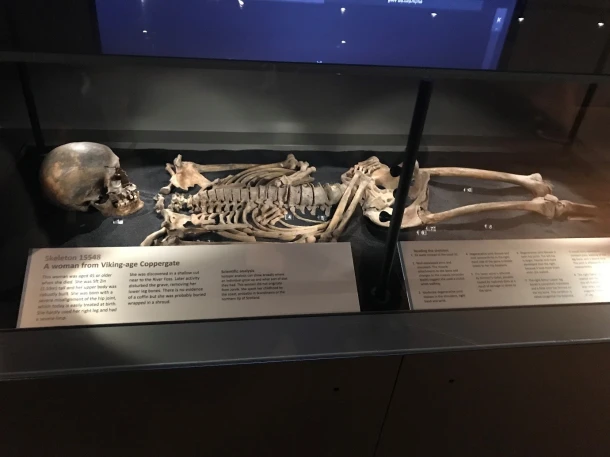Calling all history buffs and curious minds! The mystery surrounding the legendary Viking warrior, Ivar the Boneless, continues to fascinate us. Was he a ruthless barbarian, a cunning strategist, or a complex figure embodying both? Recent archaeological discoveries have shed light on the truth behind the legend, offering a glimpse into the life and times of this remarkable Viking leader.
Ivar the Boneless Skeleton Found
Imagine a burial mound teeming with the skeletal remains of hundreds of warriors – an awe-inspiring and chilling spectacle. This scene, discovered in Repton, England, sent ripples through the archaeological community. Among the fallen, one skeleton stood out, positioned amidst the others with an air of reverence. The sheer number of warriors entombed alongside this individual hinted at a leader of significant stature, possibly none other than Ivar the Boneless himself.
The sagas, those captivating tales of Norse legend, describe Ivar as having “cartilage where bone should have been.” This peculiar description has fueled centuries of speculation about his true condition. Theories abound, ranging from brittle bone disease to a debilitating battle injury. Regardless of the cause, this supposed ailment didn’t impede Ivar’s rise to power.
As one of the leaders of the Great Heathen Army, Ivar played a pivotal role in reshaping the landscape of England. His military genius was undeniable, employing cunning strategies and bold tactics to secure victory after victory. The potential discovery of his remains among a legion of warriors only reinforces his legendary status as a figure who commanded respect both in life and death.
Who Was Ivar the Boneless?
Ivar the Boneless, a name etched in the annals of history, evokes a sense of awe and trepidation. This 9th-century Viking warrior, a son of the equally renowned Ragnar Lodbrok, carved a bloody path through history. His moniker, “Boneless,” remains a source of debate among scholars. Some attribute it to his incredible agility, while others believe it stemmed from a medical condition, perhaps osteogenesis imperfecta or a physical disability that hindered his ability to walk.
Ivar’s military exploits were legendary. As a commander of the Great Heathen Army, he spearheaded the Viking invasion of England, orchestrating devastating campaigns that left a lasting impact on the island nation. His strategic brilliance was matched only by his ruthlessness. Yet, Ivar was more than a fearsome warlord. He possessed a charisma that inspired unwavering loyalty in his followers. His ability to negotiate truces and forge alliances demonstrated a political acumen that complemented his battlefield prowess.
Ivar’s story, as recounted in the sagas, paints a vivid portrait of a complex and contradictory figure – a skilled warrior, a shrewd strategist, and a leader who instilled both admiration and fear. His physical challenges, far from diminishing his impact, seemed to fuel his ambition and determination.
Where Was Ivar the Boneless’ Skeleton Found?
The final resting place of Ivar the Boneless remains a tantalizing mystery. While the mass grave unearthed in Repton, England, presents a compelling case, definitive proof linking these remains to the legendary Viking chieftain remains elusive.
Despite the lack of conclusive evidence, the search for Ivar’s final resting place continues. Historians and archaeologists meticulously piece together the fragments of his life from historical accounts, runestones, and artifacts. Each discovery adds a new layer to our understanding of this influential figure.
What Does Ivar the Boneless’ Skeleton Reveal?
The purported discovery of Ivar the Boneless’ skeleton has the potential to unlock a treasure trove of information about this enigmatic figure. By studying his remains, scientists hope to gain insight into his physical condition, his lifestyle, and perhaps even the manner of his death.
Examinations of the skeleton could reveal telltale signs of bone abnormalities, lending credence to the theory that he suffered from a congenital disorder or a disease that affected his bone growth. This discovery adds a new dimension to his legendary status, suggesting that his military achievements were all the more impressive given his potential physical limitations.
Furthermore, the skeleton holds clues about Ivar’s diet, his overall health, and any injuries he might have sustained. Was his death a result of battle wounds, or did he succumb to illness or other factors? Each bone serves as a silent witness to a life lived on the edge of history, waiting to share its secrets with those who dare to listen.
If you are interested to know where Ragnar Lothbrok was buried, click on the link and unveil the mystery. Also, did you know that according to historical sagas, Ivar the Boneless was a formidable Viking warlord and strategist.
- Unlock Filipino Culture: A Deep Dive into Traditions and Practices - April 23, 2025
- Unlock Spanish Culture: Insights & Opportunities Now - April 23, 2025
- White Spirit Uses & Substitutes: A Deep Dive for Pros & DIYers - April 23, 2025

















Comments are closed.